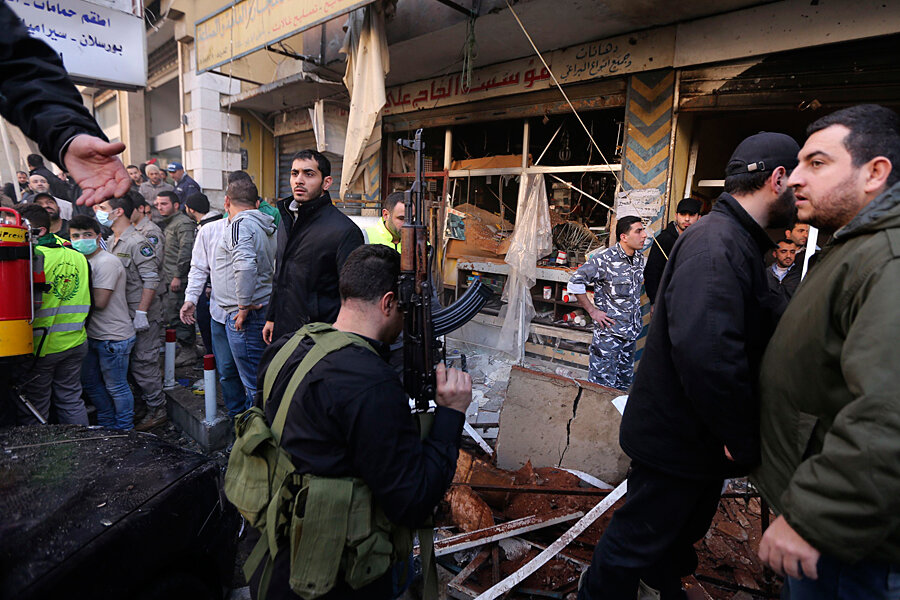Profit trumps principle on Syria weapons black market
Loading...
| Beirut, Lebanon
A glut of small arms in Syria and high weapons prices in neighboring Lebanon, where growing instability supports a thriving black market, have encouraged both Syrian soldiers and rebels to sell their surplus stock, sometimes to their battlefield enemies.
The trade in illegal weaponry in Lebanon has all the characteristics of a stock market, with prices increasing and decreasing according to the security climate and the mood on the Lebanese street. The savvy dealers buy weapons when the situation is calm and reap the commercial benefits from selling them at times of crisis. The weapons range from handguns, such as the popular 9mm Glock, to 12.5mm “Dushka” heavy machine guns and small caliber mortars.
The lure of profits from clandestine small arms sales trumps battlefield hostility. Syrian Army soldiers are selling personal weapons, some of them freshly delivered from Russia and Iran, to their rebel opponents as well as to their allies from the Lebanese Shiite militant group Hezbollah, Lebanese arms dealers say.
Syrian rebel groups once depended on smuggled arms from Lebanon. Today, the flow has reversed, underlining how much the pool of weaponry in Syria has expanded as the war approaches its third anniversary.
“It’s all coming here now. No one is sending weapons across the border to Syria anymore because there is no demand,” says Abu Rida, a grizzled, stocky arms dealer in Beirut who uses his nom de guerre to protect his identity.
Prices of weapons in Lebanon soared between 2011 and 2012, generated by demand from emerging rebel groups as the initially peaceful protests against Syrian President Bashar al-Assad morphed into an armed conflict. The ever popular Russian AK assault rifle doubled in value between March 2011, when the uprising began, and March 2012, reaching to about $2,200. In the same time frame, a US-made M4 carbine, a type of assault rifle, with an attached grenade launcher went from $13,000 to a high of $17,000. A single rocket-propelled grenade jumped from $100 to $500. Some of them came from Iraq.
The high prices spurred even arms dealers sympathetic to Hezbollah and the Assad regime to quietly sell arms to Syrian rebels, smuggling weapons across Lebanon’s porous border with Syria.
Prices remain high in Lebanon because of a worsening security climate, generated by spillover from Syria. Shiite areas of Lebanon have been repeatedly struck by suicide car bomb attacks – five so far this year, the most recent on Monday. The bombing was claimed by the Lebanese branch of the Al Qaeda-affiliated Jabhat al-Nusra in retaliation for Hezbollah’s intervention in Syria on behalf of the Assad regime.
A steady flow of weapons from Moscow
Although the Syrian Army's tightening grip on the border ended much of the arms smuggling from Lebanon to Syria, it is the steady increase in weapons in Syria that has reversed the weapons flow.
Since early 2013, Russia has increased the rate of arms deliveries by air and sea to Syria as part of a strengthened commitment to the Assad regime, according to diplomatic sources and international weapons experts. Russian officials have said they will honor existing arms contracts between Moscow and Damascus. But quantifying the amount and variety of any additional weapons is almost impossible due to the clandestine nature of the trade.
“It is often extremely difficult to track in a timely manner flows of small arms and light weapons,” says Pieter Wezeman, senior researcher with the Arms Transfers Program at the Stockholm International Peace Research Institute. “[However] that Russia has supplied major arms such as anti-ship missiles and anti-aircraft missiles is beyond doubt.”
A written purchase request allegedly made by the Syrian Army to the Russian-state-owned Rosoboronexport arms company (and leaked last May by the US watchdog Human Rights First) contained a list of 31 varieties of small arms and ammunition. It is unknown whether Russia fulfilled the Syrian request, but at least one of the listed items, the GP-30 40mm grenade launcher for the AK rifle, has begun making an appearance on the Lebanese black market.
Dealers say the GP-30, previously almost unavailable in Lebanon, has become a prestige item, with Hezbollah militants allegedly purchasing them from Syrian troops deployed with the elite 4th Armored Division. In Lebanon, the grenade launchers command a staggering $7,000 price tag, almost three times as much as the top rated AK rifle to which it is attached. Each 40mm grenade costs around $80.
Profit motive
“They [Hezbollah fighters] are not supposed to bring back weapons from Syria, but some do, either for personal use or to sell to dealers,” says Ahmad, an arms dealer from south Lebanon.
Ahmad added that he has seen a few brand new Russian AK-74M rifles emerging on the Lebanese black market that could only have come from Syria and were likely delivered recently by Russia.
Syrian troops are willing to sell to those other than their allies. Since the early days of the war, rebels have been able to purchase arms and ammunition from corrupt Syrian Army officers. And as the rebel groups have grown stronger, they have overrun Syrian Army depots and seized large quantities of weapons.
According to a diplomatic source in Beirut, Syrian troops manning an artillery post near the town of Yabroud between Damascus and Homs last year struck a covert deal with rebel groups operating in the area. The artillery gunners would routinely pound rebel areas around Yabroud, but then inform their superiors that they had expended 10 times the amount of ammunition actually used.
“The soldiers would be over-resupplied with shells and they would sell the surplus to the rebels,” the diplomat says. “The rebels then turned the shells into IEDs [Improvized Explosive Devices) on the condition that they would not use the bombs against the soldiers who sold them the shells in the first place.”







